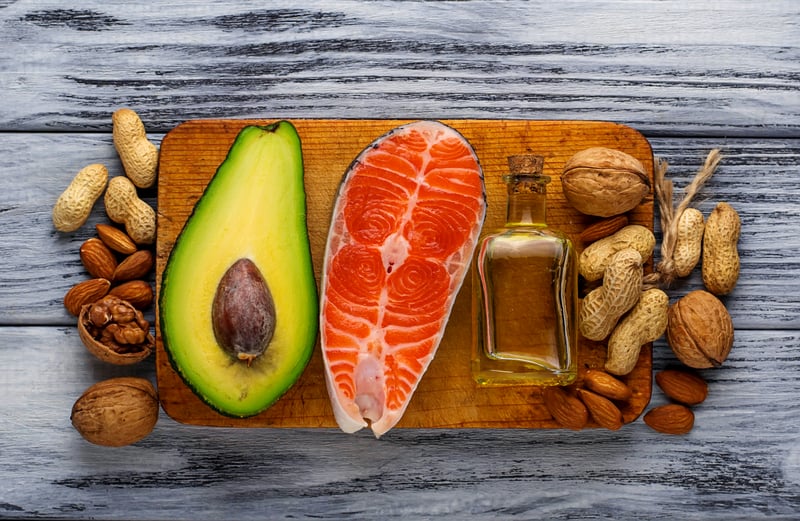9 Healthy High-Fat Foods You Need in Your Diet

Healthy fat: together these words may seem like they don’t belong together, but despite the hesitation, these are two words that commonly go hand-in-hand. This is because healthy high-fat foods in the diet can actually produce benefits, such as lowering heart disease risk, supporting cell growth, keeping cholesterol and blood pressure under control, and helping your body absorb vital nutrients. In addition, including healthful fats in a meal can create a sense of fullness, slow down the digestion of carbohydrates, and add flavor to food. But this does not apply to every type of fat. In fact, there are several different types of fats, with some being better than others.
First and foremost, when it comes to labeling certain foods, I try to avoid categorizing foods as either good or bad, healthy or unhealthy. This is because all foods can have a place in a varied, balanced diet. Nevertheless, there are some fats which are more desirable than others. This is because some fats have the ability to produce beneficial effects on the body, whereas others do not. Let’s break this down some more.
Understanding the Different Fats
When thinking broadly about the different types of fats, unsaturated fats are typically the most desirable fats, followed by saturated fats. Trans fats are the least desirable. Although this serves as a good general rule of thumb, to really understand why some fats are better than others, more needs to be considered.
Unsaturated Fats
To start, let’s dive deeper into the chemistry of unsaturated fats. Unsaturated fats can be broken down into two smaller groups: monounsaturated fat and polyunsaturated fats.
Monounsaturated fats have a single carbon-to-carbon double bond. The result is that it has minus two hydrogen atoms than a saturated fat and a bend at the double bond. Monounsaturated fats can have healthful benefits such as helping decrease the risk for heart disease by reducing blood pressure and triglycerides and reducing inflammation. 1 – 3
Polyunsaturated fats can also be broken down into two categories: omega-3 fatty acids and omega-6 fatty acids. These fats have two or more double bonds in their carbon chain and are essential fats for the body to function. However, polyunsaturated fat cannot be produced by the body, so you must consume them from the foods you eat.
There are many types of omega-3 fatty acids, but the most common are EPA, DHA, and ALA. Healthy high-fat foods rich in Omega-3 have been proven to be vital for blood clotting; supporting heart, brain, and mental health; and decreasing inflammation that can contribute to a number of chronic diseases. 4 – 7
Omega-6 fatty acids are also essential and can be beneficial. The most common omega-6 fat is linoleic acid, which can be converted into arachidonic acid (ARA). Omega-6 is considered to be pro-inflammatory, which can be good in small amounts. However, the typical Western diet contains more omega-6 fatty acids than necessary, which can put us at risk for various chronic conditions. 8,9 As a result, most people should significantly reduce their omega-6 intake and, in turn, try to replace it with alternative types of fat.
Saturated Fats
Saturated fat, on the other hand, has had a bit more debate on whether or not it should be considered a desirable type of fat. This has been due to the diet-heart hypothesis, which was set forth in the 1950’s. The diet-heart hypothesis theorized that consuming dietary cholesterol and saturated fat were a direct cause for heart disease. This hypothesis has now been discredited, due to recent research confirming saturated fat is not as harmful as once thought. 10,11 Now, it is widely accepted that saturated fat is not associated with heart disease or other adverse health outcomes. Rather, saturated fats can be beneficial in boosting metabolism and increasing energy.
Trans Fats
Trans fat is the least desirable of all the fats because not only does it raise bad LDL cholesterol but also lowers good HDL levels. Artificial trans fats can also create inflammation, which is linked to heart disease and other chronic conditions and contributes to insulin resistance, which increases your risk of developing Type 2 diabetes. Fortunately, artificial trans fat has now been banned by the Food and Drug Administration.
It is recommended that daily fat intake be in the range of 20 – 35% of total calories. However, this range can vary depending on your lifestyle and personal nutrition needs. Regardless, it is important to remember that dietary fat is essential as your body needs to perform some of its most fundamental functions. So, with all this in mind, here are nine healthy high-fat foods you need in your diet.
Top 9 Healthy High-Fat Foods
1. Eggs
Eggs can be considered one of the most nutrient-dense foods available. This is because whole eggs are loaded with vitamins, minerals, protein, and fat. The yolk, in particular, is mostly composed of monounsaturated fats.
As previously mentioned, monounsaturated fats can have healthful benefits, such as helping decrease the risk for heart disease by reducing blood pressure and triglycerides and also reducing inflammation. This is supported by a study which found that the overall fat profile in egg yolks ultimately helps reduce LDL “bad” cholesterol. 12
Not only will it improve your cholesterol, but eggs are also the number-one dietary source of a nutrient called choline. Choline is beneficial to the brain and nervous system in regulating memory, mood, muscle control, and other functions. Choline also is necessary in forming the membranes that surround your body’s cells.
2. Fatty Fish
Fatty fish such as salmon and tuna are loaded with heart-healthy omega-3 fatty acids. This type of fat has been proven to be vital for blood clotting; supporting heart, brain, and mental health; and decreasing inflammation that can contribute to a number of chronic diseases.
Studies show that people who eat fish tend to be much healthier, with a lower risk of heart disease, depression, and dementia. 13 – 15
3. Nuts
Many nuts are considered healthy high-fat foods and are often rich in fiber and protein. Studies show that people who eat nuts tend to be healthier. For example, they tend to have a decreased risk of a number of diseases, such as obesity, heart disease, and type 2 diabetes. 16 – 18 Some of the healthiest nuts include almonds, walnuts, pistachios, and macadamia nuts. Additionally, nuts are also high in fiber, vitamins, and minerals. For instance, walnuts are a healthy source of antioxidants and are especially high in vitamin E, melatonin, and polyphenols.
4. Seeds
Seeds such as flaxseeds and chia seeds contain essential omega-3 fatty acids that can aid weight maintenance and may reduce heart disease risks by promoting blood vessel health and reducing inflammation. A recent review found that omega-3s can both enhance fat-burning and decrease hunger levels. 19 Furthermore, flax and chia seeds contain powerful phenolic compounds, known as lignans, responsible for several antioxidant activities.
5. Olive Oil
Olive oil is rich in monounsaturated fats, including oleic acid, which is known for its ability to fight inflammation. As a result, olive oil is the primary source of added fat in many common diets, such as the Mediterranean diet. In addition to olive oil’s anti-inflammatory effects, studies have found that an olive-oil-rich diet resulted in higher levels of adiponectin, which is a hormone responsible for breaking down fats in the body.
6. Coconut Oil
Coconut fats are different than most other fats because it consists largely of medium-chain fatty acids which are metabolized differently in the body. Studies show that medium-chain fats can suppress appetite and can boost metabolism. 20,21 Further, lauric acid makes up about 50% of the fatty acids in coconut oil, which is known for its antibacterial properties.
7. Avocados
Avocados are about 77% fat, making them one of the highest high-fat plant foods. The main fatty acid is a monounsaturated fat in the form of oleic acid. Beyond being high in healthy fat, avocados are loaded with nutrients such as vitamins C, E, K, and B-6, as well as riboflavin, niacin, folate, pantothenic acid, magnesium, and potassium.
8. Dark Chocolate
The fat in chocolate comes from cocoa butter and is made up of equal amounts of oleic, stearic, and palmitic acids. Oleic acid is a monounsaturated fat, whereas stearic and palmitic acids are forms of saturated fat. Not only is dark chocolate rich in healthy fat, it is also loaded with antioxidants. Research even suggests that eating dark chocolate lowers the risk of heart disease. 22 Another study also found eating dark chocolate may improve brain function in older adults with mild cognitive difficulties. 23
9. Full-Fat Dairy
Full-fat dairy has long had a poor reputation; however, research suggests consuming full-fat dairy can be more beneficial than low-fat dairy options due to its protective effect on the cardiovascular system. 24 Full-fat dairy is also a rich source of other nutrients beside fat, such as calcium, potassium, and vitamins A, B, and D.





 7 Signs Your Body is Seriously Low on Collagen (not just wrinkles)
7 Signs Your Body is Seriously Low on Collagen (not just wrinkles) Health Expert: "Turmeric Doesn't Work (unless...)"
Health Expert: "Turmeric Doesn't Work (unless...)" 3 Warning Signs Your Probiotic Supplement is a Total Waste
3 Warning Signs Your Probiotic Supplement is a Total Waste

